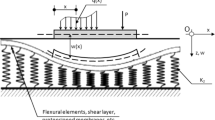Appendix A
Development of governing differential equation
$$\therefore \begin{array}{c}\begin{array}{c}{\varepsilon }_{xx}=\frac{\partial u}{\partial x}=-z\frac{\partial {\theta }_{x}}{\partial x}\end{array}\end{array} ;{\gamma }_{xz}=\frac{\partial u}{\partial z}+\frac{\partial w}{\partial x}={-\theta }_{x}+\frac{\partial w}{\partial x};$$
The strain energy deformation in Timoshenko Beam corresponding to bending and shear deformation is
$$\mathrm{Strain\; energy},{ U }=\frac{1}{2}{{\upsigma }_{{ij}}\upvarepsilon }_{{ij}}{dV}=\frac{1}{2}{{\upsigma }_{{ij}}\upvarepsilon }_{{ij}}{dxdydz}=\frac{1}{2}\int \int \int \left({{\upsigma }_{{x}}\upvarepsilon }_{{x}}+{\uptau }_{{zx}}{\upgamma }_{{xz}}\right){dxdydz}$$
$${\mathrm{U}}_{\mathrm{b}} =\frac{1}{2}{\int }_{0}^{\mathrm{L}}{\int }_{-\frac{\mathrm{h}}{2}}^{\frac{\mathrm{h}}{2}}\left[{\mathrm{Ez}}^{2}{\left(\frac{\partial {\uptheta }_{\mathrm{x}}}{\partial \mathrm{x}}\right)}^{2}+{\mathrm{\alpha G}\left(-{\uptheta }_{\mathrm{x}}+\frac{\partial \mathrm{w}}{\partial \mathrm{x}}\right)}^{2}\right]bdxdz$$
$$\therefore {\mathrm{U}}_{\mathrm{b}} =\frac{\mathrm{E}}{2}{\int }_{0}^{\mathrm{L}}{\int }_{-\frac{\mathrm{h}}{2}}^{\frac{\mathrm{h}}{2}}{\mathrm{z}}^{2}{\left(\frac{\partial {\uptheta }_{\mathrm{x}}}{\partial \mathrm{x}}\right)}^{2}bdzdx+{\int }_{0}^{\mathrm{L}}{\int }_{-\frac{\mathrm{h}}{2}}^{\frac{\mathrm{h}}{2}}{\frac{\mathrm{\alpha {\rm A}}\mathrm{G}}{2}\left(-{\uptheta }_{\mathrm{x}}+\frac{\partial \mathrm{w}}{\partial \mathrm{x}}\right)}^{2}bdzdx$$
where E – is the Young’s modulus of beam material, I- is the second moment of inertia of the beam section G—is the modulus rigidity of beam material, b – is the beam width and α – is the shear correction factor.
$${{U}}_{{b}} =\frac{{EI}}{2}{\int }_{0}^{{L}}{\left(\frac{\partial {\uptheta }_{{x}}}{\partial {x}}\right)}^{2}dx+\frac{{\alpha AG}}{2}{\int }_{0}^{{L}}{\left(-{\uptheta }_{{x}}+\frac{\partial {w}}{\partial {x}}\right)}^{2}dx;A-is\; the\; cross\; sectional\; area\; of\; the\; beam.$$
$$\Pi =\frac{{EI}}{2}{\int }_{0}^{{L}}{\left(\frac{\partial {\uptheta }_{{x}}}{\partial {x}}\right)}^{2}dx+\frac{{\alpha AG}}{2}{\int }_{0}^{{L}}{\left(-{\uptheta }_{{x}}+\frac{\partial {w}}{\partial {x}}\right)}^{2}dx+\frac{1}{2}{\int }_{0}^{{L}}{{kw}}^{2}\mathrm{dx}-{\int }_{0}^{{L}}{qwdx}$$
Now, to obtain the equilibrium equations, we can use the calculus of variations. The first variation of the potential energy must be zero (δΠ = 0) in order for a stable equilibrium state to be achieved. From 0 to L we consider the first beam soil system and take variations on w. We get the following by making variations on w.
$$\mathrm{F}=\frac{\mathrm{EI}}{2}{\left(\frac{\partial {\uptheta }_{\mathrm{x}}}{\partial \mathrm{x}}\right)}^{2}+\frac{\mathrm{\alpha AG}}{2}{\left(-{\uptheta }_{\mathrm{x}}+\frac{\partial \mathrm{w}}{\partial \mathrm{x}}\right)}^{2}+\frac{1}{2}{\mathrm{kw}}^{2}-\mathrm{qw}$$
$$\mathrm{F}=\frac{\mathrm{EI}}{2}{\left(\frac{\partial {\uptheta }_{\mathrm{x}}}{\partial \mathrm{x}}\right)}^{2}+\frac{\mathrm{\alpha AG}{{\uptheta }_{\mathrm{x}}}^{2}}{2}-\mathrm{KAG}{\uptheta }_{\mathrm{x}}\frac{\partial \mathrm{w}}{\partial \mathrm{x}}+\frac{\mathrm{\alpha AG}}{2}{\left(\frac{\mathrm{dw}}{\mathrm{dx}}\right)}^{2}+\frac{1}{2}{\mathrm{kw}}^{2}-\mathrm{qw};$$
$$\frac{\partial \mathrm{F}}{\partial \mathrm{w}}-\frac{\mathrm{d}}{\mathrm{dx}}\left(\frac{\partial \mathrm{F}}{\partial \left(\frac{\mathrm{dw}}{\mathrm{dx}}\right)}\right)=0$$
(1)
$$\frac{\partial \mathrm{F}}{\partial {\uptheta }_{\mathrm{x}}}-\frac{\mathrm{d}}{\mathrm{dx}}\left(\frac{\partial \mathrm{F}}{\partial \left(\frac{\partial {\uptheta }_{\mathrm{x}}}{\partial \mathrm{x}}\right)}\right)=0$$
(2)
is known as Euler – Lagrange equation and the governing static equations of equilibrium state of elastic body.
$$\frac{\partial {F}}{\partial \mathrm{w}}={kw}-{q}; \frac{\partial {F}}{\partial \left(\frac{{dw}}{{dx}}\right)}={\alpha AG}\left(-{\uptheta }_{{x}}+\frac{\partial {w}}{\partial {x}}\right);\frac{\partial {F}}{\partial {\uptheta }_{{x}}}={\alpha AG}{\uptheta }_{{x}}-{\alpha AG}\frac{\partial {w}}{\partial {x}}{ and }\frac{\partial {F}}{\partial \left(\frac{\partial {\uptheta }_{{x}}}{\partial {x}}\right)}={EI}\frac{\partial {\uptheta }_{{x}}}{\partial {x}}$$
Substitute in Eq. (1) one get, \({kw}-{q}-\frac{{d}}{{dx}}\left({\alpha AG}\left({-\uptheta }_{{x}}+\frac{\partial {w}}{{\partial }_{{x}}}\right)\right)=0\therefore -{\alpha AG}\left(-\frac{\partial {\uptheta }_{{x}}}{\partial {x}}+\frac{{{d}}^{2}{w}}{{{dx}}^{2}}\right)+{kw}-{q}=0\)
$$\therefore \mathrm{\alpha AG}\frac{{\mathrm{d}}^{2}\mathrm{w}}{{\mathrm{dx}}^{2}}-\mathrm{\alpha AG}\frac{\partial {\uptheta }_{\mathrm{x}}}{\partial \mathrm{x}}-\mathrm{kw}+\mathrm{q}=0;$$
(3)
Substitute in Eq. (2) one get, \({\alpha AG}{\uptheta }_{{x}}-{\alpha AG}\frac{\partial {w}}{\partial {x}}-\frac{{d}}{{dx}}\left({EI}\frac{\partial {\uptheta }_{{x}}}{\partial {x}}\right)=0\therefore {\alpha AG}{\uptheta }_{{x}}-{\alpha AG}\frac{\partial {w}}{\partial {x}}-{EI}\frac{{\mathrm{d}}^{2}{\uptheta }_{{x}}}{{{dx}}^{2}}=0\)
$$\therefore \mathrm{EI}\frac{{\mathrm{d}}^{2}{\uptheta }_{\mathrm{x}}}{{\mathrm{dx}}^{2}}+\mathrm{\alpha AG}\frac{\partial \mathrm{w}}{\partial \mathrm{x}}-\mathrm{\alpha AG}{\uptheta }_{\mathrm{x}}=0;$$
(4)
Equations (3) and (4) are couple governing differential equation of beams on Winkler foundation.
Decoupling the differential equations of equilibrium
$$\frac{{dM}}{{dx}}={Q\; and\; }\frac{{dQ}}{{dx}}=-{q};{M}=-{EI}\frac{\partial {\uptheta }_{{x}}}{\partial {x}}\therefore \frac{{dM}}{{dx}}=-{EI}\frac{{{d}}^{2}{\uptheta }_{{x}}}{{{dx}}^{2}}={Q};\therefore \frac{{dQ}}{{dx}}=-{EI}\frac{{{d}}^{3}{\uptheta }_{{x}}}{{{dx}}^{3}}=-{q}\therefore \frac{{{d}}^{3}{\uptheta }_{{x}}}{{{dx}}^{3}}=\frac{{q}}{{EI}}$$
From Eq. (3), \({\alpha AG}\frac{{{d}}^{2}{w}}{{{dx}}^{2}}-{\alpha AG}\frac{\partial {\uptheta }_{{x}}}{\partial {x}}-{kw}+{q}=0 \therefore {\alpha AG}\frac{{{d}}^{3}{\uptheta }_{{x}}}{{{dx}}^{3}}-{\alpha AG}\frac{{{d}}^{4}{w}}{{{dx}}^{4}}+{k}\frac{{{d}}^{2}{w}}{{{dx}}^{2}}=\frac{{{d}}^{2}{q}}{{{dx}}^{2}}\)
$$\mathrm{Substituting }\frac{{\mathrm{d}}^{3}{\uptheta }_{\mathrm{x}}}{{\mathrm{dx}}^{3}}=\frac{\mathrm{q}}{\mathrm{EI}} \therefore \frac{\mathrm{\alpha AGq}}{\mathrm{EI}}-\mathrm{\alpha AG}\frac{{\mathrm{d}}^{4}\mathrm{w}}{{\mathrm{dx}}^{4}}+\mathrm{k}\frac{{\mathrm{d}}^{2}\mathrm{w}}{{\mathrm{dx}}^{2}}=\frac{{\mathrm{d}}^{2}\mathrm{q}}{{\mathrm{dx}}^{2}}$$
$$\mathrm{\alpha AGq}-\mathrm{EI\alpha AG}\frac{{\mathrm{d}}^{4}\mathrm{w}}{{\mathrm{dx}}^{4}}+\mathrm{EIk}\frac{{\mathrm{d}}^{2}\mathrm{w}}{{\mathrm{dx}}^{2}}=\mathrm{EI}\frac{{\mathrm{d}}^{2}\mathrm{q}}{{\mathrm{dx}}^{2}}\therefore \mathrm{EI\alpha AG}\frac{{\mathrm{d}}^{4}\mathrm{w}}{{\mathrm{dx}}^{4}}-\mathrm{EIk}\frac{{\mathrm{d}}^{2}\mathrm{w}}{{\mathrm{dx}}^{2}}+\mathrm{EI}\frac{{\mathrm{d}}^{2}\mathrm{q}}{{\mathrm{dx}}^{2}}=\mathrm{\alpha AGq}$$
Beam without foundation k = 0;
$$\therefore \mathrm{EI}\frac{{\mathrm{d}}^{4}\mathrm{w}}{{\mathrm{dx}}^{4}}+\frac{\mathrm{EI}}{\mathrm{\alpha AG}}\frac{{\mathrm{d}}^{2}\mathrm{q}}{{\mathrm{dx}}^{2}}=\mathrm{q}$$
Appendix B
$${{N}}_{{w}1}=\frac{1}{\left(1+5{\varphi }-20{{\varphi }}^{2}\right)\left(4{\varphi }+1\right)}\left[\frac{24\left(4{\varphi }+1\right){{x}}^{5}}{{{L}}^{5}}-\frac{4{{x}}^{4}\left(-40{{\varphi }}^{2}+70{\varphi }+17\right)}{{{L}}^{4}}+\frac{6{{x}}^{3}\left(-80{{\varphi }}^{2}+40{\varphi }+11\right)}{{{L}}^{3}}-\frac{{{x}}^{2}\left(160{{\varphi }}^{3}-440{{\varphi }}^{2}+32{\varphi }+23\right)}{{{L}}^{2}}-\frac{3{x}\left(-80{{\varphi }}^{3}+40{{\varphi }}^{2}+11{\varphi }\right)}{{L}}+\left(1+5{\varphi }-20{{\varphi }}^{2}\right)\left(4{\varphi }+1\right)\right]$$
$${{N}}_{{w}2}=\frac{1}{\left(1+5{\varphi }-20{{\varphi }}^{2}\right)}\left[-\frac{4\left(2{\varphi }-1\right){{x}}^{5}}{{{L}}^{4}}-\frac{6\left(-20{{\varphi }}^{2}+5{\varphi }+2\right){{x}}^{4}}{\left(4{\varphi }+1\right){{L}}^{3}}+\frac{\left(-160{{\varphi }}^{2}+36{\varphi }+13\right){{x}}^{3}}{\left(4{\varphi }+1\right){{L}}^{2}}-\frac{3\left(-60{{\varphi }}^{2}+11{\varphi }+4\right){{x}}^{2}}{2{L}\left(4{\varphi }+1\right)}+\frac{\left(-36{{\varphi }}^{2}+5{\varphi }+2\right){x}}{2\left(4{\varphi }+1\right)}\right]$$
$${\mathrm{N}}_{\mathrm{w}3}=\frac{1}{\left(4\mathrm{\varphi }+1\right)}\left[\frac{16{\mathrm{x}}^{4}}{{\mathrm{L}}^{4}}-\frac{32{\mathrm{x}}^{3}}{{\mathrm{L}}^{3}}-\frac{16{\mathrm{x}}^{2}\left(\mathrm{\varphi }-1\right)}{{\mathrm{L}}^{2}}+\frac{16\mathrm{\varphi x}}{\mathrm{L}}\right]$$
$${{N}}_{{w}4}=\frac{32{{x}}^{3}}{-20{{L}}^{2}{{\varphi }}^{2}+5{{L}}^{2}{\varphi }+{{L}}^{2}}-\frac{40{{x}}^{4}\left({\varphi }+1\right)}{-20{{L}}^{3}{{\varphi }}^{2}+5{{L}}^{3}{\varphi }+{{L}}^{3}}+\frac{16{{x}}^{5}\left({\varphi }+1\right)}{-20{{L}}^{4}{{\varphi }}^{2}+5{{L}}^{4}{\varphi }+{{L}}^{4}}-\frac{16{\varphi x}}{-20{{\varphi }}^{2}+5{\varphi }+1}+\frac{8{{x}}^{2}\left(5{\varphi }-1\right)}{-20{L}{{\varphi }}^{2}+5{L\varphi }+{L}}$$
$${{N}}_{{w}5}=-\frac{24{{x}}^{5}}{-20{{L}}^{5}{{\varphi }}^{2}+5{{L}}^{5}{\varphi }+{{L}}^{5}}+\frac{4\left(40{{\varphi }}^{2}+50{\varphi }+13\right){{x}}^{4}}{\left(4{\varphi }+1\right)\left(-20{{L}}^{4}{{\varphi }}^{2}+5{{L}}^{4}{\varphi }+{{L}}^{4}\right)}-\frac{2\left(80{{\varphi }}^{2}+40{\varphi }+17\right){{x}}^{3}}{\left(4{\varphi }+1\right)\left(-20{{L}}^{3}{{\varphi }}^{2}+5{{L}}^{3}{\varphi }+{{L}}^{3}\right)}-\frac{\left(160{{\varphi }}^{3}+40{{\varphi }}^{2}+32{\varphi }-7\right){{x}}^{2}}{\left(4{\varphi }+1\right)\left(-20{{L}}^{2}{{\varphi }}^{2}+5{{L}}^{2}{\varphi }+{{L}}^{2}\right)}+\frac{\left(80{{\varphi }}^{3}+40{{\varphi }}^{2}+17{\varphi }\right){x}}{\left(4{\varphi }+1\right)\left(-20{L}{{\varphi }}^{2}+5{L\varphi }+{L}\right)}$$
$${{N}}_{{w}6}=-\frac{4{{x}}^{5}\left(2{\varphi }-1\right)}{-20{{L}}^{4}{{\varphi }}^{2}+5{{L}}^{4}{\varphi }+{{L}}^{4}}-\frac{{x}\left(-4{{\varphi }}^{2}+5{\varphi }\right)}{2\left(4{\varphi }+1\right)\left(-20{{\varphi }}^{2}+5{\varphi }+1\right)}-\frac{{{x}}^{3}\left(4{\varphi }-5\right)}{\left(4{\varphi }+1\right)\left(-20{{L}}^{2}{{\varphi }}^{2}+5{{L}}^{2}{\varphi }+{{L}}^{2}\right)}-\frac{{{x}}^{2}\left(20{{\varphi }}^{2}-17{\varphi }+2\right)}{2\left(4{\varphi }+1\right)\left(-20{L}{{\varphi }}^{2}+5{L\varphi }+{L}\right)}-\frac{2{{x}}^{4}\left(-20{{\varphi }}^{2}+5{\varphi }+4\right)}{\left(4{\varphi }+1\right)\left(-20{{L}}^{3}{{\varphi }}^{2}+5{{L}}^{3}{\varphi }+{{L}}^{3}\right)}$$
$${{N}}_{\uptheta }=\left\{\begin{array}{c}\frac{120{{x}}^{4}}{5{{L}}^{5}{\varphi }+{{L}}^{5}}-\frac{2{x}\left(100{\varphi }+23\right)}{\left(5{\varphi }+1\right)\left(4{{L}}^{2}{\varphi }+{{L}}^{2}\right)}-\frac{16{{x}}^{3}\left(70{\varphi }+17\right)}{\left(5{\varphi }+1\right)\left(4{{L}}^{4}{\varphi }+{{L}}^{4}\right)}+\frac{6{{x}}^{2}\left(140{\varphi }+33\right)}{\left(5{\varphi }+1\right)\left(4{{L}}^{3}{\varphi }+{{L}}^{3}\right)}\\ -\frac{20\left(2{\varphi }-1\right){{x}}^{4}}{5{{L}}^{4}{\varphi }+{{L}}^{4}}-\frac{8\left(-40{{\varphi }}^{2}+15{\varphi }+6\right){{x}}^{3}}{\left(5{\varphi }+1\right)\left(4{{L}}^{3}{\varphi }+{{L}}^{3}\right)}+\frac{\left(-160{{\varphi }}^{2}+128{\varphi }+39\right){{x}}^{2}}{\left(5{\varphi }+1\right)\left(4{{L}}^{2}{\varphi }+{{L}}^{2}\right)}-\frac{\left(20{{\varphi }}^{2}+57{\varphi }+12\right){x}}{\left(5{\varphi }+1\right)\left({L}+4{L\varphi }\right)}+1\\ \frac{64{{x}}^{3}}{4{{L}}^{4}{\varphi }+{{L}}^{4}}-\frac{96{{x}}^{2}}{4{{L}}^{3}{\varphi }+{{L}}^{3}}+\frac{32{x}}{4{{L}}^{2}{\varphi }+{{L}}^{2}}\\ \frac{80{{x}}^{4}\left({\varphi }+1\right)}{{{L}}^{4}\left(5{\varphi }+1\right)}-\frac{160{{x}}^{3}\left({\varphi }+1\right)}{{{L}}^{3}\left(5{\varphi }+1\right)}-\frac{16{x}}{{L}\left(5{\varphi }+1\right)}+\frac{16{{x}}^{2}\left(5{\varphi }+6\right)}{{{L}}^{2}\left(5{\varphi }+1\right)}\\ -\frac{120{{x}}^{4}}{5{{L}}^{5}{\varphi }+{{L}}^{5}}+\frac{16\left(50{\varphi }+13\right){{x}}^{3}}{\left(5{\varphi }+1\right)\left(4{{L}}^{4}{\varphi }+{{L}}^{4}\right)}-\frac{6\left(60{\varphi }+17\right){{x}}^{2}}{\left(5{\varphi }+1\right)\left(4{{L}}^{3}{\varphi }+{{L}}^{3}\right)}+\frac{2\left(20{\varphi }+7\right){x}}{\left(5{\varphi }+1\right)\left(4{{L}}^{2}{\varphi }+{{L}}^{2}\right)}\\ -\frac{20\left(2{\varphi }-1\right){{x}}^{4}}{5{{L}}^{4}{\varphi }+{{L}}^{4}}-\frac{8\left(-40{{\varphi }}^{2}+5{\varphi }+4\right){{x}}^{3}}{\left(5{\varphi }+1\right)\left(4{{L}}^{3}{\varphi }+{{L}}^{3}\right)}+\frac{\left(-160{{\varphi }}^{2}+8{\varphi }+15\right){{x}}^{2}}{\left(5{\varphi }+1\right)\left(4{{L}}^{2}{\varphi }+{{L}}^{2}\right)}+\frac{\left(20{{\varphi }}^{2}+{\varphi }-2\right){x}}{\left(5{\varphi }+1\right)\left({L}+4{L\varphi }\right)}\end{array}\right.$$
where φ = 12D/(SL2) and D = EI, S = αAG.
$${\mathrm{U}}_{\mathrm{Beam}} =\frac{\mathrm{EI}}{2}{\int }_{0}^{\mathrm{L}}{\left(\frac{\partial {\uptheta }_{\mathrm{x}}}{\partial \mathrm{x}}\right)}^{2}dx+\frac{\mathrm{\alpha AG}}{2}{\int }_{0}^{\mathrm{L}}{\left(-{\uptheta }_{\mathrm{z}}+\frac{\partial \mathrm{w}}{\partial \mathrm{x}}\right)}^{2}dz$$
$${\mathrm{U}}_{\mathrm{Beam}} =\frac{1}{2}{\int }_{0}^{\mathrm{L}}\mathrm{EI}{\left\{\mathrm{d}\right\}}^{\mathrm{T}}{\left[{N}_{\varphi }\mathrm{^{\prime}}\right]}^{\mathrm{T}}\left[{N}_{\varphi }\mathrm{^{\prime}}\right]\left\{\mathrm{d}\right\}dx+\frac{1}{2}{\int }_{0}^{\mathrm{L}}\mathrm{\alpha AG}{\left\{\mathrm{d}\right\}}^{\mathrm{T}}{\left(-\left[{N}_{\varphi }\right]+\left[{N}_{w}\mathrm{^{\prime}}\right]\right)}^{\mathrm{T}}\left(-\left[{N}_{\varphi }\right]+\left[{N}_{w}\mathrm{^{\prime}}\right]\right)\left\{\mathrm{d}\right\}dx$$
$${\mathrm{U}}_{\mathrm{Beam}} =\frac{1}{2}{\left\{\mathrm{d}\right\}}^{\mathrm{T}}\left[{\mathrm{K}}_{\mathrm{b}}\right]\left\{\mathrm{d}\right\}+\frac{1}{2}{\left\{\mathrm{d}\right\}}^{\mathrm{T}}\left[{\mathrm{K}}_{\mathrm{s}}\right]\left\{\mathrm{d}\right\}$$
$$\mathrm{Bending stiffness matrix}, \left[{\mathrm{K}}_{\mathrm{b}}\right]={\int }_{0}^{\mathrm{L}}\mathrm{EI}{\left[{N}_{\varphi }\mathrm{^{\prime}}\right]}^{\mathrm{T}}\left[{N}_{\varphi }\mathrm{^{\prime}}\right]dx$$
$$and\; {shear\; stiffness\; matrix}, \left[{{K}}_{{s}}\right]={\int }_{0}^{{L}}{EI}{\left(-\left[{N}_{\varphi }\right]+\left[{N}_{w}{^{\prime}}\right]\right)}^{{T}}\left(-\left[{N}_{\varphi }\right]+\left[{N}_{w}{^{\prime}}\right]\right)dx$$
$${\uptheta }_{{x}}=\left[{N}_{\varphi }\right]\left\{{d }\right\}{ and w}=\left[{N}_{w}\right]\left\{{d }\right\}{ where\; d\; is\; the\; displacement\; vector}.$$
According to the theory of elasticity, the strain energy Ur in a linear spring is given as 1/2Kw2.
$${\mathrm{U}}_{\mathrm{sk}}=\frac{1}{2}{\int }_{0}^{\mathrm{L}}{\mathrm{Kw}}^{2}\mathrm{dA}=\frac{\mathrm{Kb}}{2}{\int }_{0}^{\mathrm{L}}{\mathrm{w}}^{2}\mathrm{dx}=\frac{\mathrm{k}}{2}{\int }_{0}^{\mathrm{L}}{\mathrm{w}}^{2}\mathrm{dx };\mathrm{ K is the soil parameter}.$$
$$\mathrm{Strain energy }{\mathrm{U}}_{\mathrm{sk}}=\frac{1}{2}{\int }_{0}^{\mathrm{L}}\mathrm{k}{\left\{\mathrm{d}\right\}}^{\mathrm{T}}{\left[{N}_{w}\right]}^{\mathrm{T}}\left[{N}_{w}\right]\left\{\mathrm{d}\right\}\mathrm{dx }= \frac{1}{2}{\left\{\mathrm{d}\right\}}^{\mathrm{T}}\left[{\mathrm{K}}_{\mathrm{f}}\right]\left\{\mathrm{d}\right\}$$
In which the foundation stiffness matrix for the element is \([{\mathrm{K}}_{\mathrm{f}}] ={\int }_{0}^{\mathrm{L}}\mathrm{k}{\left[{N}_{w}\right]}^{\mathrm{T}}\left[{N}_{w}\right]\mathrm{dx}\)
Hence the element stiffness matrix is
$$\therefore \left[{\mathrm{k}}_{\mathrm{e}}\right]=\left[{\mathrm{K}}_{\mathrm{b}}\right]+\left[{\mathrm{K}}_{\mathrm{s}}\right]+\left[{\mathrm{K}}_{\mathrm{f}}\right]$$
By using standard finite element procedure the global stiffness matrix is obtained
$$\therefore \left[{\mathrm{K}}_{\mathrm{S}}\right]=\sum_{1}^{\mathrm{n}}\left(\left[{\mathrm{K}}_{\mathrm{b}}\right]+\left[{\mathrm{K}}_{\mathrm{s}}\right]+\left[{\mathrm{K}}_{\mathrm{f}}\right]\right)$$
(5)
The nodal load vector is determined by the virtual work principle using the Lagrangian interpolation. The force vector for uniformly varying load of intensity w1, w2 and w3 at three nodes respectively is the quadratic polynomial that passes through the three data points. This element has nodes at x = (0, L/2, L).
$${fe}=\left[\begin{array}{ccc}\frac{L\left(-4480{\varphi}^3-680{\varphi}^2+374\varphi +57\right)}{420\left(-80{\varphi}^3+9\varphi +1\right)}& \frac{L\left(28\varphi +11\right)}{105\left(4\varphi +1\right)}& \frac{L\left(1120{\varphi}^3+440{\varphi}^2+64\varphi -3\right)}{420\left(-80{\varphi}^3+9\varphi +1\right)}\\ {}\frac{L^2\left(-140{\varphi}^2+7\varphi +6\right)}{840\left(-80{\varphi}^3+9\varphi +1\right)}& \frac{L^2}{105\left(4\varphi +1\right)}& \frac{L^2\varphi \left(20\varphi +23\right)}{840\left(-80{\varphi}^3+9\varphi +1\right)}\\ {}\frac{4L\left(7\varphi +1\right)}{105\left(4\varphi +1\right)}& \frac{16L\left(14\varphi +3\right)}{105\left(4\varphi +1\right)}& \frac{4L\left(7\varphi +1\right)}{105\left(4\varphi +1\right)}\\ {}-\frac{2{L}^2\left(15\varphi +1\right)}{105\left(-20{\varphi}^2+5\varphi +1\right)}& 0& \frac{2{L}^2\left(15\varphi +1\right)}{105\left(-20{\varphi}^2+5\varphi +1\right)}\\ {}\frac{L\left(1120{\varphi}^3+440{\varphi}^2+64\varphi -3\right)}{420\left(-80{\varphi}^3+9\varphi +1\right)}& \frac{L\left(28\varphi +11\right)}{105\left(4\varphi +1\right)}& \frac{L\left(-4480{\varphi}^3-680{\varphi}^2+374\varphi +57\right)}{420\left(-80{\varphi}^3+9\varphi +1\right)}\\ {}-\frac{L^2\varphi \left(20\varphi +23\right)}{840\left(-80{\varphi}^3+9\varphi +1\right)}& -\frac{L^2}{105\left(4\varphi +1\right)}& -\frac{L^2\left(-140{\varphi}^2+7\varphi +6\right)}{840\left(-80{\varphi}^3+9\varphi +1\right)}\end{array}\right]\left\lfloor \begin{array}{c}{{w}}_1\\ {}{{w}}_2\\ {}{{w}}_3\end{array}\right\rfloor$$













